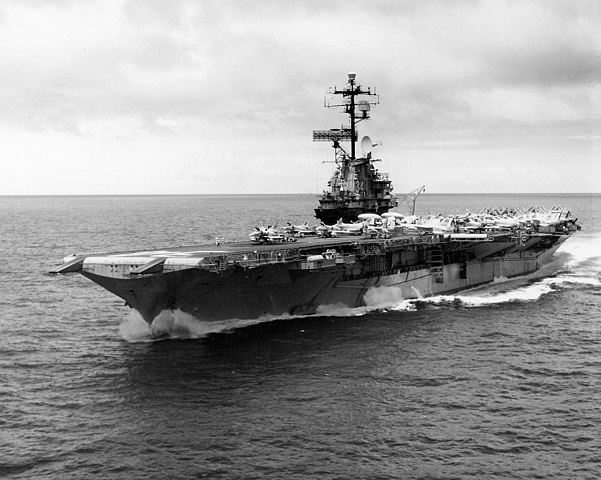How to Recycle Thousands of Tons of Military-Grade Metal

Pictured above is the USS Oriskany, an American aircraft carrier. In the image above, this huge warship was patrolling the Pacific, near Midway Atoll, supporting American fighter planes as they engaged in the Vietnam War. The field (or oceans) of battle weren’t anything new for the Oriskany; it received two battle stars for its service in the Korean War and would receive five more for its service in Vietnam.
But about two decades after the picture above was taken, the Oriskany finally fell prey to the bombs and explosions On May 17, 2006, explosion after explosion rang out throughout the ship; before the hour was out, the Oriskany was gone — it was sunk.
And you know what? The U.S. military didn’t really mind. In fact, they probably were pretty excited about it. And so were the fish.
(Okay, fish can’t really get excited; they don’t have the emotional range. But put that aside.)
When it was first commissioned in 1950, the Oriskany was among the American military’s most advanced tools. Its long and storied service history — that section of its Wikipedia entry runs well over 3,000 words — underscores its importance to the military during its time in use. But ultimately, military technology surpassed that of the ship. It was decommissioned in September of 1976 and sat in limbo for years — the Navy kept it in storage in case it needed to mobilize a larger fleet until 1989. That need never came to pass so the military stripped the ship of anything useful and then tried to find a buyer for the rest. After a few false starts, though, the Navy found itself without a buyer. So in 2004, they decided to send it to the bottom of the ocean.
Or, more accurately, the Navy decided to take the Oriskany into the Gulf of Mexico near Pensacola, Florida, and sink the ship, turning the 30,000-ton ship into one of the world’s largest artificial reefs in the process. Due to environmental reviews and to avoid a rather nasty hurricane season, the actual sinking didn’t happen until the spring of 2006. On May 17th of that year, a team of Navy explosive experts detonated more than 500 pounds of strategically-placed C-4, and about a half hour later, the Oriskany was on its way to the bottom of the Gulf, taking the first step to becoming a home for schools of fish and other sea life.
Today, the “Great Carrier Reef,” as the ship is now often called, is seen by many as an ecological success but others as an ecological failure — as Atlas Obscura notes, “although the Navy removed most blatantly hazardous materials from the ship before sinking it, they ended up leaving in some insulation, paint, and fiberglass that contains polychlorinated biphenyl, or PCB, a harmful chemical that was banned in the U.S. in 1979.” Regardless, it isn’t going anywhere — it’s not like exhuming a massive ship like that is an easy job, and in any event, the Oriskany has now become part of the ecosystem — and the local economy. The ship has become a home for “goliath grouper, sunfish, eagle rays, tuna, amberjack and tropical fish,” according to Florida’s official tourism website, while also doubling as a tourist hotspot for those into deep sea diving.
Want a virtual tour of the Oriskany? In 2008, the New York Times published a 4-minute video featuring dive footage of the intentional wreck; you can watch it here.
Bonus fact: The Oriskany makes a cameo in the blockbuster 1986 movie Top Gun — kind of. The protagonist, pilot Pete “Maverick” Mitchell (played by Tom Cruise) is haunted throughout the movie by the death of his father, Duke Mitchell. Duke was himself a pilot but was killed during the Vietnam War when his plane was shot down by enemy fire. The fictional Duke Mitchell served on the (very real) Oriskany.
From the Archives: Cleaning Up: How actor Kevin Costner helped clean up the Gulf of Mexico.
